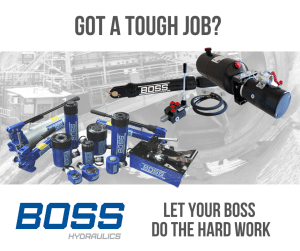
Hydraulic cylinders work by using pressurized fluid to generate a force that can be used to move an object. The cylinder consists of a piston that moves back and forth inside the cylinder barrel, which is sealed at both ends. The piston is connected to a rod that extends out of one end of the cylinder and can be used to transmit the force generated by the cylinder.
When fluid under pressure is introduced into the cylinder on one side of the piston, it pushes the piston to the other side of the cylinder, extending the rod. When the fluid is removed from one side of the piston and introduced on the other side, the piston moves in the opposite direction, retracting the rod. By controlling the flow of fluid into and out of the cylinder, the movement of the piston and rod can be precisely controlled.
Hydraulic cylinders are used in a wide variety of applications, including:
- Construction: Hydraulic cylinders are used in heavy equipment such as excavators, bulldozers, and backhoes to power the movement of the arms and buckets.
- Manufacturing: Hydraulic cylinders are used in industrial machinery such as presses, stamping machines, and injection moulding machines to provide the force needed to operate the equipment.
- Transportation: Hydraulic cylinders are used in automobiles, trucks, and buses to power brakes, steering systems, and suspension systems.
- Agriculture: Hydraulic cylinders are used in tractors and other farming equipment to power the movement of ploughs, harvesters, and other attachments.
- Marine: Hydraulic cylinders are used in ship propulsion systems and cargo handling equipment, such as cranes.
- Aerospace: Hydraulic systems are used in control surfaces, landing gear and braking systems.
- Medical: Hydraulic cylinders are used in hospital beds, patient lifts and other medical equipment that requires precise and controlled movement.
- Energy and oil industry: Hydraulic cylinders are used in drilling and production operations, such as controlling the movement of the drill head and closing and opening valves.
- Material handling: Hydraulic cylinders are used in forklifts, cranes, and other material handling equipment to power the movement of the lift mechanism.
High force and low pressure hydraulic cylinders refer to the characteristics of the cylinder’s output.
A high force hydraulic cylinder is able to generate a large amount of force, but requires a relatively low pressure of fluid to do so. This type of cylinder is typically used in applications where a large amount of force is needed, but the cylinder does not need to move very far. For example, a high force cylinder might be used to exert a large amount of pressure on a piece of metal in a stamping machine.
A low pressure, high flow hydraulic cylinder commonly known as an AG or agricultural cylinder, is able to generate a smaller amount of force, but requires a relatively high pressure of fluid to do so. This type of cylinder is typically used in applications where the cylinder needs to move a large distance, but the force needed is not as high. For example, a low pressure, high flow cylinder might be used to raise and lower a lift truck’s boom.
For more information about the BOSS range of both high force and low pressure cylinders visit www.bosshydraulics.com.au
